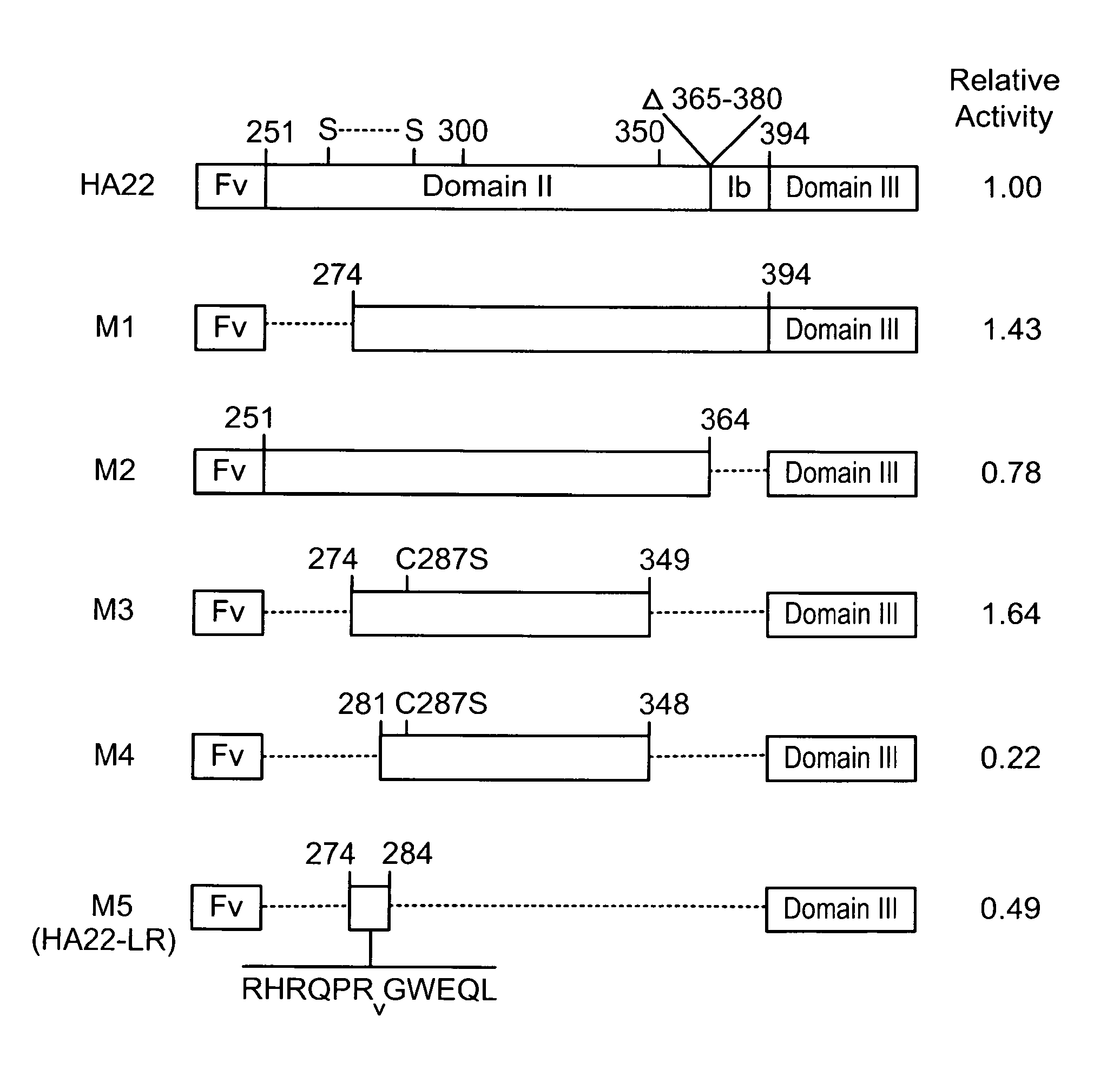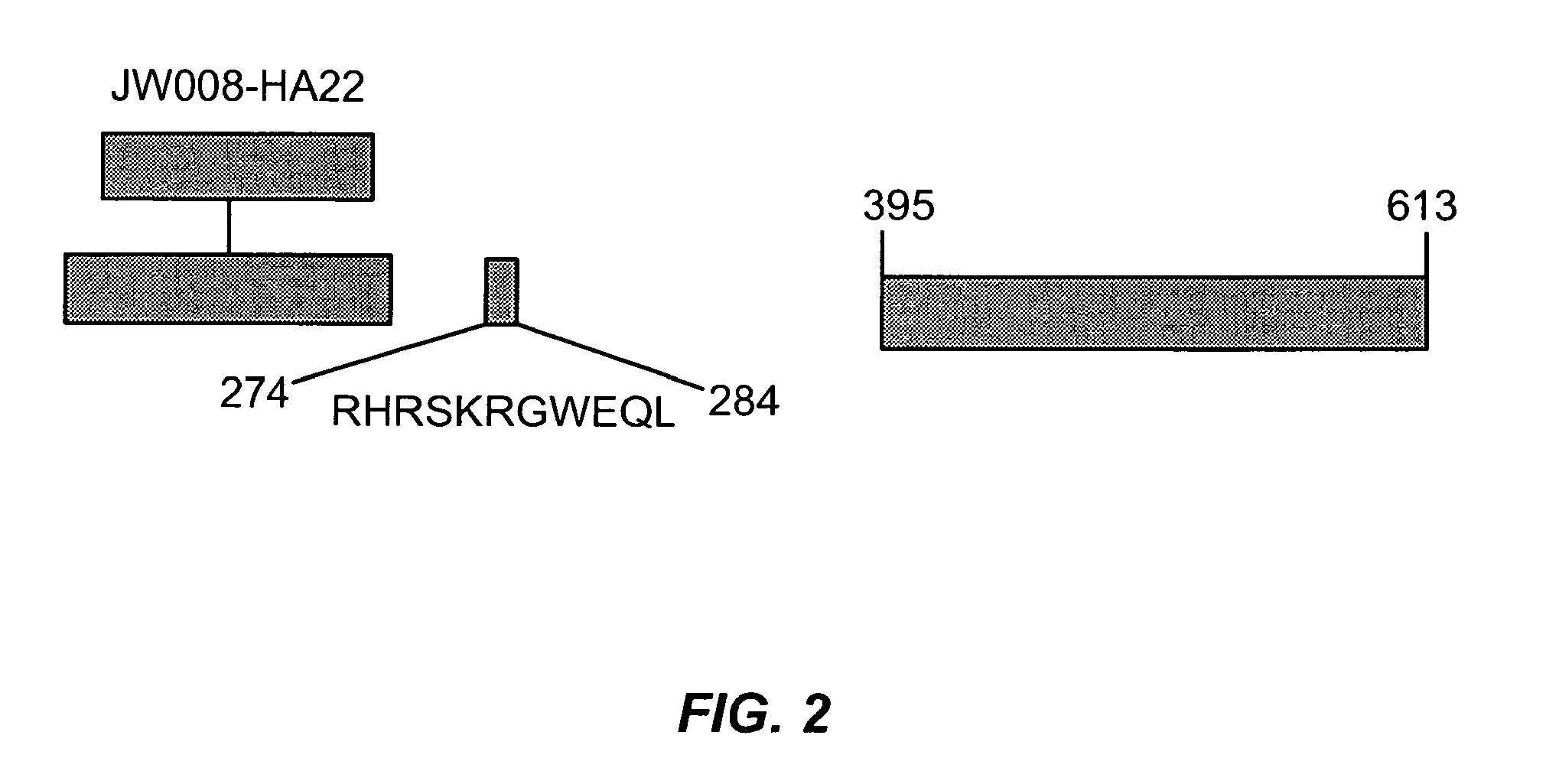Deletions in domain II of pseudomonas exotoxin a that remove immunogenic epitopes
a pseudomonas exotoxin and epitope technology, applied in the field of deletions, can solve the problems of high immunogenicity of pe-based immunotoxins currently in clinical trials, limited therapeutic effect, and unsatisfactory current pe-based immunotoxins
- Summary
- Abstract
- Description
- Claims
- Application Information
AI Technical Summary
Benefits of technology
Problems solved by technology
Method used
Image
Examples
example 1
[0176]This Example sets forth materials and methods used in some of the studies underlying the present invention.
Lysosomal Preparation of Raji Cells
[0177]Raji Burkitt's lymphoma cells (1-3×108) were harvested, washed twice in cold PBS, once in homogenization buffer (250 mM sucrose, 1 mM EDTA) and resuspended in 2 ml of homogenization buffer. Cells in suspension were lysed by nitrogen cavitation with a 45 ml-cell disruption bomb (Parr Instrument Company, Moline, Ill.) chilled to 4° C. and pressurized with nitrogen gas to 150-200 psi for 10 min. The disrupted cells were spun at 800×g for 10 min. The post-nuclear supernatant (middle layer) was removed and layered atop an 8.5 ml 27% PERCOLL® solution cushioned on a 1.2 ml layer of 10× homogenization buffer in a 16×76 Ultraclear Beckman centrifuge tube (Beckman Coulter, Inc., Fullerton, Calif.) and spun at 4° C. in a Beckman Type 50 Ti rotor for 1 h at 36,000×g. Fractions from the PERCOLL® gradient were collected and then assayed individ...
example 2
[0189]This Example sets forth the results of PE lysosomal protease cleavage studies. Immunotoxins are internalized into cells via target-mediated endocytosis, and must reach the cytosol to exert their toxic effect. Since lysosomes are the major degradative pathway for exogenous, internalized macromolecules, immunotoxins must avoid lysosomal degradation on their path to the cytosol (Fitzgerald, D., Semin Cancer Biol, 7:87-95 (1996)). Therefore, studies were performed to determine if an immunotoxin could be produced by identifying and removing lysosomal protease cleavage sites in the immunotoxin.
Lysosomal Protease Digestion of Immunotoxins
[0190]To determine the location of the lysosomal protease cleavage sites within immunotoxins, a large quantity of a highly purified immunotoxin was required. A large stock of immunotoxin B3(dsFv)-PE38, which contains the same PE38 fragment as HA22 but with a different Fv as the targeting moiety, was available (Reiter, Y. et al., Cancer Res, 54:2714-2...
example 3
[0197]This Example sets forth the results of studies of the activity of HA22-LR on CD22-positive cell lines.
[0198]The activity of HA22-LR was investigated on additional CD22-positive tumor cell lines and compared to HA22 using a paired, two-tailed t-test between the resulting IC50 values (Table 1). HA22-LR had activity indistinguishable from HA22 on the Ramos (n=3), CA46 (n=5), and Daudi (n=3) lymphoma cell lines, but had significant differences against the WSU-CLL cell line (212% activity, p=0.01, n=4), the KOPN-8 ALL cell line (22% activity, p=0.01, n=3), and the Raji cell line (49%, p=0.0002, n=10). Although there is some variability in the activity of HA22-LR, HA22-LR and HA22 had generally similar activities on CD22-positive cell lines.
[0199]
TABLE 1Activity of HA22 and HA22-LR on six CD22-positive cell linesIC50 ± SE (ng / ml)Cell LineHA22HA22-LRRelative ActivityCA46 (n = 5)0.30 ± 0.080.26 ± 0.061.15Daudi (n = 3)0.27 ± 0.040.24 ± 0.041.12Ramos (n = 3)1.62 ± 0.281.78 ± 0.150.91Raj...
PUM
| Property | Measurement | Unit |
|---|---|---|
| pH | aaaaa | aaaaa |
| average bond energy | aaaaa | aaaaa |
| temperature | aaaaa | aaaaa |
Abstract
Description
Claims
Application Information
 Login to View More
Login to View More - R&D
- Intellectual Property
- Life Sciences
- Materials
- Tech Scout
- Unparalleled Data Quality
- Higher Quality Content
- 60% Fewer Hallucinations
Browse by: Latest US Patents, China's latest patents, Technical Efficacy Thesaurus, Application Domain, Technology Topic, Popular Technical Reports.
© 2025 PatSnap. All rights reserved.Legal|Privacy policy|Modern Slavery Act Transparency Statement|Sitemap|About US| Contact US: help@patsnap.com



